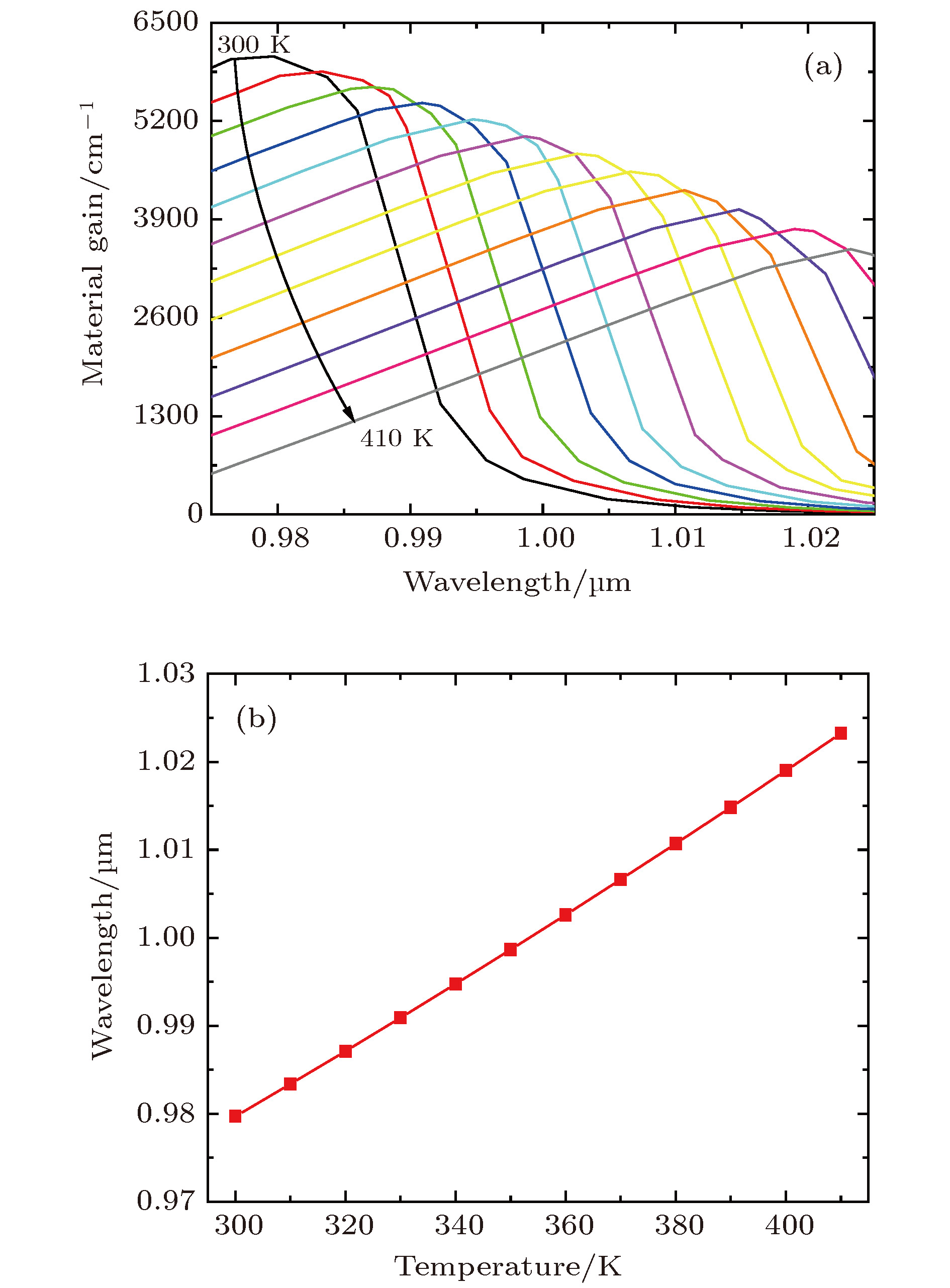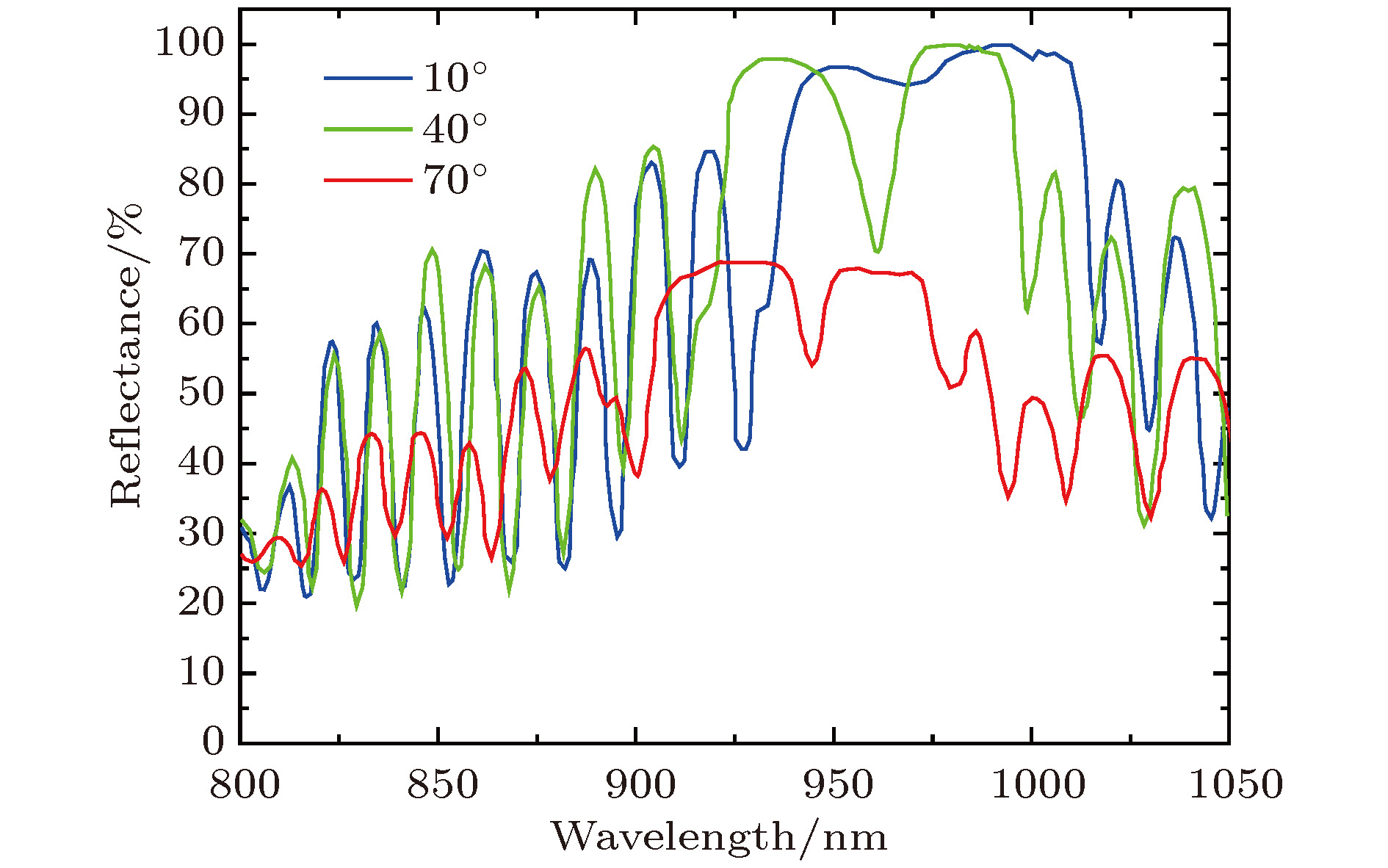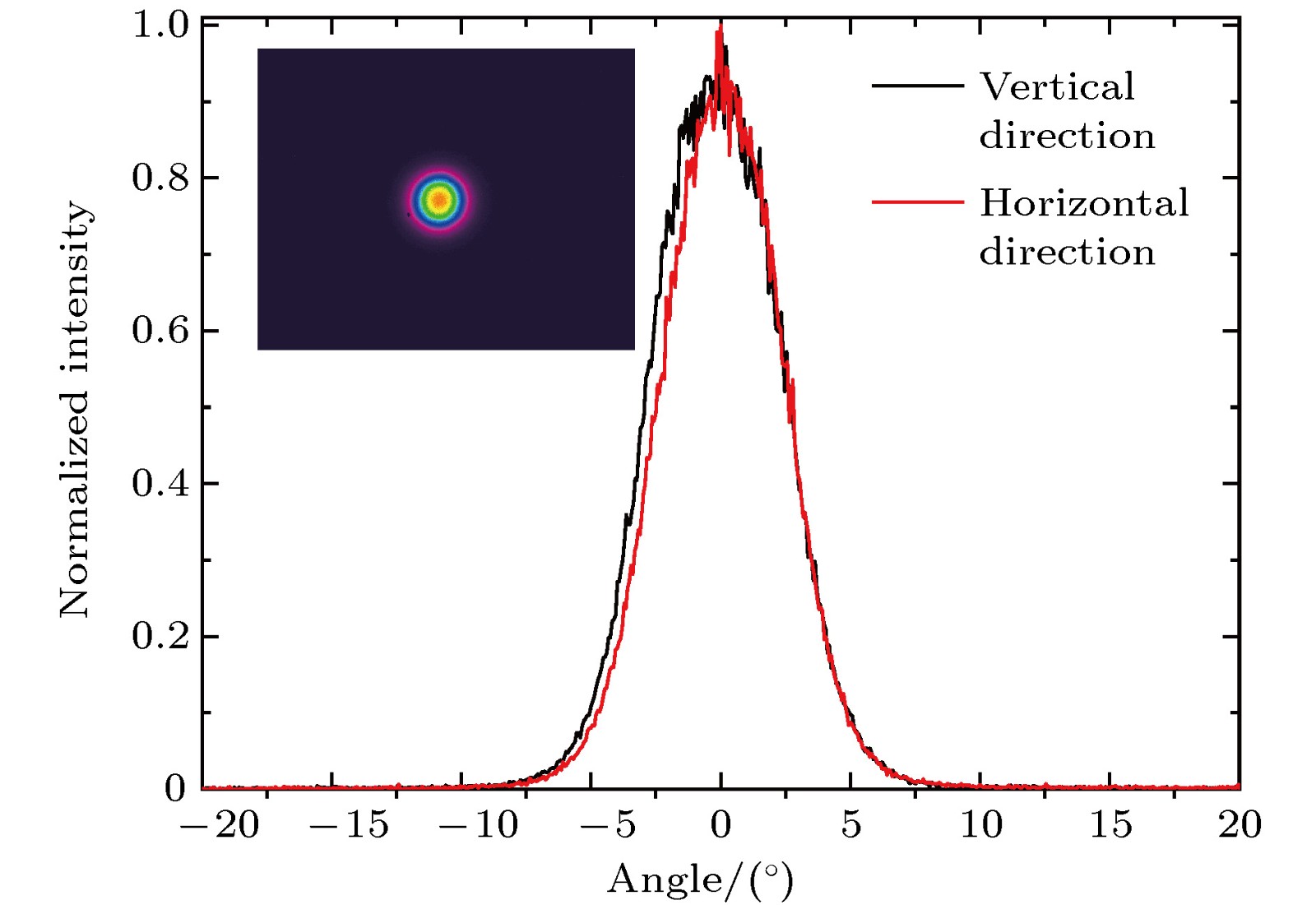-
The vertical external cavity surface emitting laser (VECSEL) is one of the hottest research fields of semiconductor lasers, due to its high power and good beam quality. However, there are few reports about how to systematically design the active region of VECSEL. In this paper, the gain design of quantum wells, which are the most important region within the VECSEL, is carried out. To achieve low power consumption under high temperature condition, epitaxial structure of the VECSEL is optimized by using the commercial software PICS3D. Firstly, the relationship between the structure of quantum well and the gain is simulated by the k·p method. Then, the gain spectra of quantum wells at different carrier densities and temperatures are compared with each other, and the optimal composition and thickness of quantum well are thus determined. The temperature drift coefficient is 0.36 nm/K, obtained by simulating the drift of the gain peak wavelength at the working temperature. Finally, the gain spectra of quantum wells with five different barriers are compared with each other. The slight blue shift of the gain peak in the quantum well with five different barriers accommodates the different emission thermal drifts of the quantum well at high temperature operation. With the GaAsP barriers on both sides of quantum well the gain characteristics of quantum wells can be improved efficiently. The designed structure is deposited by the MOCVD system. According to the reflection spectrum of the gain chip, measured by ellipsometer, the stop-band over 100 nm is centered at the about 970 nm wavelength, confirming accurate growth of the VECSEL. The 808 nm pump laser is focused on the surface of VECSEL chip at an incident angle from 30° to 50°. The VECSEL light-light characteristics are tested under the output coupling mirror with different reflectivity. The output power of VECSEL with a 97.7% reflectance output coupling mirror reaches 9.82 W at the pumping power of 35 W, without saturating the power curve. By using the external mirrors with different reflectivity, there appears the wavelength shift with the pumping power changing from 0.216 nm/W to 0.16 nm/W. Thus, the internal heating effects are different for VECSEL with different mirrors. The divergence angles at two orthogonal directions are 9.2° and 9.0°, respectively. And the circle profile of optical field shows good symmetry. -
Keywords:
- optically-pumped vertical external cavity surface emitting semiconductor laser /
- quantum well /
- gain chip /
- high power
[1] 王立军, 宁永强, 秦莉, 佟存柱, 陈泳屹 2015 发光学报 36 1
 Google Scholar
Google Scholar
Wang L J, Ning Y Q, Qin L, Tong C Z, Chen Y Y 2015 Chin. J. Lumin. 36 1
 Google Scholar
Google Scholar
[2] Hall R N, Fenner G E, Kingsley J D, Soltys T J, CarlsonR O 1962 Phys. Rev. Lett. 9 366
 Google Scholar
Google Scholar
[3] Soda H, Iga K, Kitahara C, Suematsu Y 1979 Jpn. J. Appl. Phys. 18 2329
 Google Scholar
Google Scholar
[4] Tian Z N, Wang L J, Chen Q D, Jiang T, Qin L, Wang LJ, Sun H B 2013 Opt. Lett. 38 5414
 Google Scholar
Google Scholar
[5] 崔锦江, 宁永强, 姜琛昱, 王帆, 高静, 张星, 王贞福, 武晓东, 檀慧明 2011 中国激光 38 0102002
 Google Scholar
Google Scholar
Cui J J, Ning Y Q, Jiang C Y, Wang F, Gao J, Zhang X, Wang Z F, Wu X D, Tan X H 2011 Chin. J. Lasers 38 0102002
 Google Scholar
Google Scholar
[6] Kuznetsov M, Hakimi F, Sprague R, Mooradian A 1997 IEEE J. Sel. Top. Quantum Electron. 9 1063
 Google Scholar
Google Scholar
[7] Hein A, Demaria F, Kern A, Menzel S, Rinaldi F, Rösch R, Unger P 2011 IEEE Photonics Technol. Lett. 23 179
 Google Scholar
Google Scholar
[8] Zhang P, Jiang M H, Men Y B, Zhu R J, Liang Y P, Zhang Y 2015 Opt. Quantum Electron. 47 423
 Google Scholar
Google Scholar
[9] Tilma B W, Mangold M, Zaugg C A, Link S M, Waldburger D, Klenner A, Mayer A S, Gini E, Golling M, Keller U 2015 Light Sci. Appl. 4 e310
 Google Scholar
Google Scholar
[10] Tropper A C, Hoogland S 2006 Prog. Quantum Electron. 30 1
 Google Scholar
Google Scholar
[11] Rahimi-Iman A 2016 J. Opt. 18 093003
 Google Scholar
Google Scholar
[12] Yoo J, Kim K, Lee S, Lim S, Kim G, Kim J, Cho S, Lee J, Kim T, Park Y 2006 Appl. Phys. Lett. 89 131125
 Google Scholar
Google Scholar
[13] Rudin B, Rutz A, Hoffmann M, Maas D J H C, Bellancourt A R, Gini E, Südmeyer T, Keller U 2008 Opt. Lett. 33 2719
 Google Scholar
Google Scholar
[14] Mereuta A, Nechay K, Caliman A, Suruceanu G, Rudra A, Gallo P, Guina M, Kapon E 2019 IEEE J. Sel. Top. Quantum Electron. 25 1700605
 Google Scholar
Google Scholar
[15] Broda A, Kuz′micz A, Rychlik G, Chmielewski K, Wójcik-Jedlin′ska A, Sankowska I, Gołaszewska-Malec K, Michalak K, Muszalski J 2017 Opti. Quantum Electron. 49 287
 Google Scholar
Google Scholar
[16] Guoyu H, Kriso C, Zhang F, Wichmann M, Stolz W, Fedorova K A, Rahimi-Iman A 2019 Opt. Lett. 44 4000
 Google Scholar
Google Scholar
[17] 邱小浪, 陈雪花, 朱仁江, 张鹏, 郭于鹤洋, 宋晏蓉 2019 中国激光 46 14
 Google Scholar
Google Scholar
Qiu X L, Chen X H, Zhu R J, Zhang P, Guo Y H Y, Song Y R 2019 Chin. J. Lasers 46 14
 Google Scholar
Google Scholar
[18] 邱小浪, 王爽爽, 张晓健, 朱仁江, 张鹏, 郭于鹤洋, 宋晏蓉 2019 68 114204
 Google Scholar
Google Scholar
Qiu X L, Wang X X, Zhang X J, Zhu R J, Zhang P, Guo Y H Y, Song Y R 2019 Acta Phys. Sin. 68 114204
 Google Scholar
Google Scholar
[19] Kouznetsov D, Bisson J F, Ueda K 2009 Opt. Mater. 31 754
 Google Scholar
Google Scholar
[20] Chang C S, Chuang S L 1995 IEEE J. Sel. Top. Quantum Electron. 1 218
 Google Scholar
Google Scholar
[21] Corzine S W, Geels R S, Scott J W, Yan R H, Coldren L A 1989 IEEE J. Quantum Electron. 25 1513
 Google Scholar
Google Scholar
[22] Zhang J, Ning Y, Zeng Y, Zeng Y, Zhang J, Zhang J, Fu X, Tong C, Wang L 2013 Laser Phys. Lett. 10 045802
 Google Scholar
Google Scholar
[23] 朱仁江, 潘英俊, 张鹏, 戴特力, 范嗣强, 梁一平 2014 红外与毫米波学报 33 272
 Google Scholar
Google Scholar
Zhu R J, Pan Y J, Zhang P, Tai T L, Fan S Q, Liang Y P 2014 J. Infrared Millim. Waves 33 272
 Google Scholar
Google Scholar
[24] Laurain A, Schelle M, Wang T L, Hader J, Moloney J V, Koch S W, Heinen B, Koch M, Kunert B, Stolz W 2012 High- Power Lasers 2012: Technology and Systems (Edinburgh: Society of Photo-Optical Instrumentation Engineers) p85470 I-1
-
图 2 (a) 室温下InGaAs量子阱的发光波长为970, 975, 980 nm时, 量子阱中In组分与厚度的关系; (b) 增益峰值在980 nm InGaAs量子阱增益光谱对比; (c) 对应980 nm波长的InGaAs量子阱的价带结构(HH1, 第一重空穴; LH1, 第一轻空穴);
Figure 2. (a) Relationships between the In content and thickness of quantum wells when its emitting wavelength is 970, 975, 980 nm; (b) the gain spectra of different quantum wells with the same gain peak wavelength of 980 nm; (c) the valence subband structures of InGaAs QWs corresponding to a wavelength of 980 nm (HH1, the first heavy hole subband; LH1, the first light hole subband.).
表 1 模拟的5种发光区材料结构
Table 1. Simulated material structures of 5 kinds of luminous zone.
1 Al0.06Ga0.94As barrier/InGaAs QW/
Al0.06Ga0.94As barrier2 GaAs barrier/InGaAs QW/GaAs barrier 3 GaAsP barrier/InGaAs QW/GaAsP barrier 4 GaAsP/GaAs barrier/InGaAs QW/GaAs barrier/GaAsP 5 GaAs barrier/InGaAs QW/GaAsP barrier -
[1] 王立军, 宁永强, 秦莉, 佟存柱, 陈泳屹 2015 发光学报 36 1
 Google Scholar
Google Scholar
Wang L J, Ning Y Q, Qin L, Tong C Z, Chen Y Y 2015 Chin. J. Lumin. 36 1
 Google Scholar
Google Scholar
[2] Hall R N, Fenner G E, Kingsley J D, Soltys T J, CarlsonR O 1962 Phys. Rev. Lett. 9 366
 Google Scholar
Google Scholar
[3] Soda H, Iga K, Kitahara C, Suematsu Y 1979 Jpn. J. Appl. Phys. 18 2329
 Google Scholar
Google Scholar
[4] Tian Z N, Wang L J, Chen Q D, Jiang T, Qin L, Wang LJ, Sun H B 2013 Opt. Lett. 38 5414
 Google Scholar
Google Scholar
[5] 崔锦江, 宁永强, 姜琛昱, 王帆, 高静, 张星, 王贞福, 武晓东, 檀慧明 2011 中国激光 38 0102002
 Google Scholar
Google Scholar
Cui J J, Ning Y Q, Jiang C Y, Wang F, Gao J, Zhang X, Wang Z F, Wu X D, Tan X H 2011 Chin. J. Lasers 38 0102002
 Google Scholar
Google Scholar
[6] Kuznetsov M, Hakimi F, Sprague R, Mooradian A 1997 IEEE J. Sel. Top. Quantum Electron. 9 1063
 Google Scholar
Google Scholar
[7] Hein A, Demaria F, Kern A, Menzel S, Rinaldi F, Rösch R, Unger P 2011 IEEE Photonics Technol. Lett. 23 179
 Google Scholar
Google Scholar
[8] Zhang P, Jiang M H, Men Y B, Zhu R J, Liang Y P, Zhang Y 2015 Opt. Quantum Electron. 47 423
 Google Scholar
Google Scholar
[9] Tilma B W, Mangold M, Zaugg C A, Link S M, Waldburger D, Klenner A, Mayer A S, Gini E, Golling M, Keller U 2015 Light Sci. Appl. 4 e310
 Google Scholar
Google Scholar
[10] Tropper A C, Hoogland S 2006 Prog. Quantum Electron. 30 1
 Google Scholar
Google Scholar
[11] Rahimi-Iman A 2016 J. Opt. 18 093003
 Google Scholar
Google Scholar
[12] Yoo J, Kim K, Lee S, Lim S, Kim G, Kim J, Cho S, Lee J, Kim T, Park Y 2006 Appl. Phys. Lett. 89 131125
 Google Scholar
Google Scholar
[13] Rudin B, Rutz A, Hoffmann M, Maas D J H C, Bellancourt A R, Gini E, Südmeyer T, Keller U 2008 Opt. Lett. 33 2719
 Google Scholar
Google Scholar
[14] Mereuta A, Nechay K, Caliman A, Suruceanu G, Rudra A, Gallo P, Guina M, Kapon E 2019 IEEE J. Sel. Top. Quantum Electron. 25 1700605
 Google Scholar
Google Scholar
[15] Broda A, Kuz′micz A, Rychlik G, Chmielewski K, Wójcik-Jedlin′ska A, Sankowska I, Gołaszewska-Malec K, Michalak K, Muszalski J 2017 Opti. Quantum Electron. 49 287
 Google Scholar
Google Scholar
[16] Guoyu H, Kriso C, Zhang F, Wichmann M, Stolz W, Fedorova K A, Rahimi-Iman A 2019 Opt. Lett. 44 4000
 Google Scholar
Google Scholar
[17] 邱小浪, 陈雪花, 朱仁江, 张鹏, 郭于鹤洋, 宋晏蓉 2019 中国激光 46 14
 Google Scholar
Google Scholar
Qiu X L, Chen X H, Zhu R J, Zhang P, Guo Y H Y, Song Y R 2019 Chin. J. Lasers 46 14
 Google Scholar
Google Scholar
[18] 邱小浪, 王爽爽, 张晓健, 朱仁江, 张鹏, 郭于鹤洋, 宋晏蓉 2019 68 114204
 Google Scholar
Google Scholar
Qiu X L, Wang X X, Zhang X J, Zhu R J, Zhang P, Guo Y H Y, Song Y R 2019 Acta Phys. Sin. 68 114204
 Google Scholar
Google Scholar
[19] Kouznetsov D, Bisson J F, Ueda K 2009 Opt. Mater. 31 754
 Google Scholar
Google Scholar
[20] Chang C S, Chuang S L 1995 IEEE J. Sel. Top. Quantum Electron. 1 218
 Google Scholar
Google Scholar
[21] Corzine S W, Geels R S, Scott J W, Yan R H, Coldren L A 1989 IEEE J. Quantum Electron. 25 1513
 Google Scholar
Google Scholar
[22] Zhang J, Ning Y, Zeng Y, Zeng Y, Zhang J, Zhang J, Fu X, Tong C, Wang L 2013 Laser Phys. Lett. 10 045802
 Google Scholar
Google Scholar
[23] 朱仁江, 潘英俊, 张鹏, 戴特力, 范嗣强, 梁一平 2014 红外与毫米波学报 33 272
 Google Scholar
Google Scholar
Zhu R J, Pan Y J, Zhang P, Tai T L, Fan S Q, Liang Y P 2014 J. Infrared Millim. Waves 33 272
 Google Scholar
Google Scholar
[24] Laurain A, Schelle M, Wang T L, Hader J, Moloney J V, Koch S W, Heinen B, Koch M, Kunert B, Stolz W 2012 High- Power Lasers 2012: Technology and Systems (Edinburgh: Society of Photo-Optical Instrumentation Engineers) p85470 I-1
Catalog
Metrics
- Abstract views: 16005
- PDF Downloads: 393
- Cited By: 0















 DownLoad:
DownLoad:







